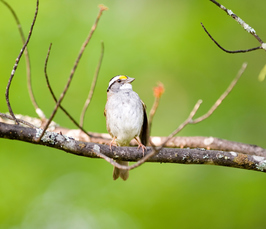Andrea and Melissa Grunst, University of Antwerp: Interconnections between behaviour, sexual selection and senescence in a dimorphic bird with a supergene
Talk Andrea and Melissa Grunst, Seewiesen
- Datum: 03.12.2020
- Uhrzeit: 13:00 - 14:00
- Vortragende(r): Andrea and Melissa Grunst
- University of Antwerp
- Ort: Seewiesen
- Raum: Online
- Gastgeber: Dr. Clemens Küpper
- Kontakt: ckuepper@orn.mpg.de

The white-throated sparrow (Zonotrichia albicollis) is an ordinary looking songbird with extraordinary genetics. Both sexes exist in either a white-striped or tan-striped morph, as determined by a >100-Mb inversion-based supergene on the second chromosome. White morph birds are almost all heterozygous for the supergene, suggesting that homozygousity is deleterious. Tan morph birds are homozygous without the supergene. The supergene is associated with a suite of coadapted traits that are expressed by both white males and females, including higher levels of aggressiveness, song and copulation, and lower levels of parental care. Due to behavioral and genetic incompatibilities within white male x white female pairs, white-throated sparrows pair dissassortively by morph. Tan males and white females share parental care relatively equally, whereas white males provide little paternal support to tan partners. We leveraged this unique system and an 18-year long-term dataset regarding reproduction and survivorship to test different evolutionary theories of aging, and elucidate how differences in actuarial and reproductive senescence might affect the balance in fitness between morphs. On one hand, some theories of aging suggest that competitive traits, such as those associated with the supergene, have high physiological costs and promote a live-fast-die-young strategy and faster senescence. On the other hand, intense investment in parental care, as in the tan morph, can also have costs. Furthermore, a more cooperative reproductive strategy, as observed in tan males x white femalepairs, might lessen reproductive costs and dampen senescence rates. Our data do not support high costs of the competitive traits associated with the morph-determining supergene, but rather suggest high costs of unsupported parental care, and that cooperative reproductive strategies might dampen rates of senescence. To better understand how genetics contribute to morph differences in life-history and senescence, more work is needed regarding how specific genes within the supergene affect physiological and self-maintenance differences between the morphs. Such work will ultimately advance understanding of how supergenes promote the persistence of multiple morphs with distinct life-history strategies within a species.